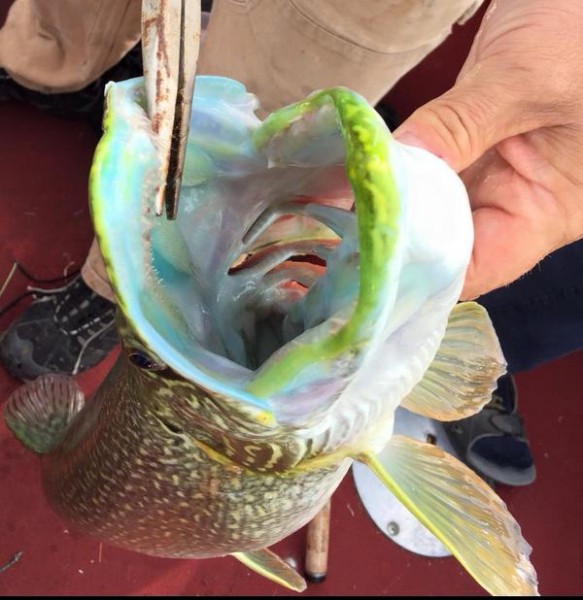Why is This Northern Pike Neon Green? Experts Have Answers
OutdoorHub Reporters 09.01.15

It’s not nuclear mutation or a new species, so that rules out the more interesting answers, but why is this northern pike fluorescent green? Canadian angler Randy Straker caught this bizarre-looking fish from Great Slave Lake in Canada’s Northwest Territories on Sunday, but he still has not figured out what gave the fish its strange color.
“The whole top of the fish had a different green,” he told the CBC. “If you look at the mouth, it looked like green lipstick. It was so bright.”
Straker was fishing with a friend, Craig Thomas, and neither men immediately noticed the fish’s odd coloration due to their sunglasses. Yet when Straker moved to bring the pike in, he stared down the fish’s mouth and noticed that its throat was a startlingly bright green. It was like nothing he had ever seen before.
Despite his curiosity, Straker ultimately decided to release the pike. With the fish gone, all he had to go on was the pictures he took, and Straker put them online in a search for answers. Some of the most common theories were that the fish was affected by pollution, a natural adaptation from the pike, or even as a result of nuclear mutation. In 1978, a Soviet-built reconnaissance satellite with an on-board nuclear reactor fell from orbit and crashed in pieces across the lake. Even though most of the wreckage was retrieved by Canadian and American officials, some believe that the radiation may still affect local animals, such as this green pike. Some even argued that the fish may have been affected by radiation from faraway Fukushima.
Others speculated that the pike could be a new species, or that diet issues may have caused the green color.
“Interest in the Neon Pike continues to draw interest from all over,” Straker posted to Twitter with a picture of pike with its mouth open. “Maybe an answer on the colour is coming.”
Sure enough, the pictures drew the attention of experts like fish and wildlife technician Jeff Goudreau, who said the answer is actually much simpler than everyone thought.
Goudreau stated that he had previously caught neon-green pike himself and believes the color is due to the fish’s chromatophores. Chromatophores are pigment-containing and light-reflecting cells that give fish—as well as amphibians, reptiles, and a wide array of other animals—their color. These cells are what allow creatures like squids to change color depending on their mood, and also allow fish to adapt to their environments.
Goudreau told CBC that it is likely that Straker’s pike merely spent a lot of time near green algae and took on the color as well.
“They try to blend themselves into that environment to be better hunters,” he said. “So you’ll see those aquamarine colors, where the throats are very blue and dark green and stuff. That’s pretty much what’s happened, with that one.”
Great Slave Lake in particular holds pike of many color variations as it is the deepest lake in North America and the tenth largest in the world. Its name comes from the Slavey people, one of the Athapaskan tribes that lived near the lake and relied on it for fishing.


